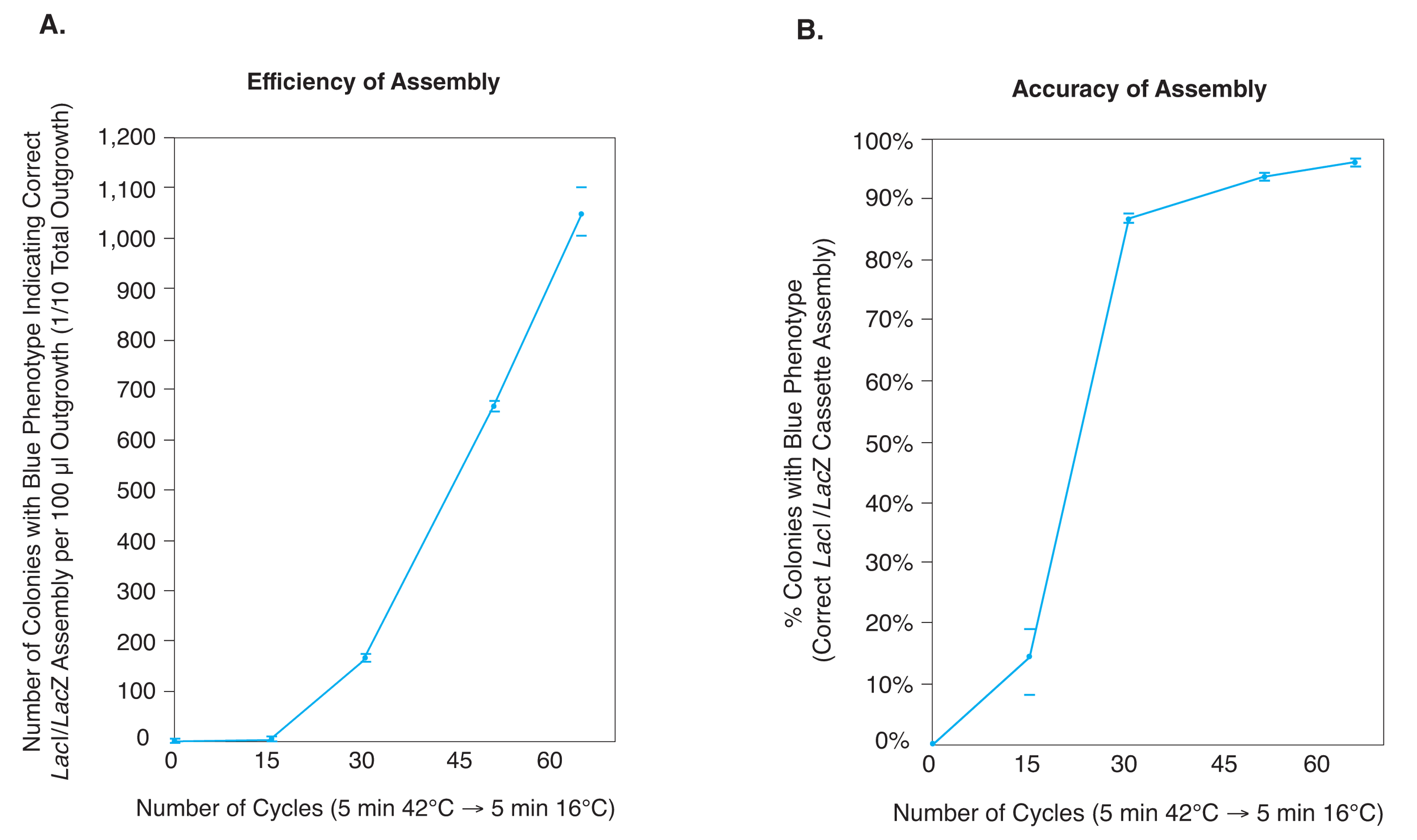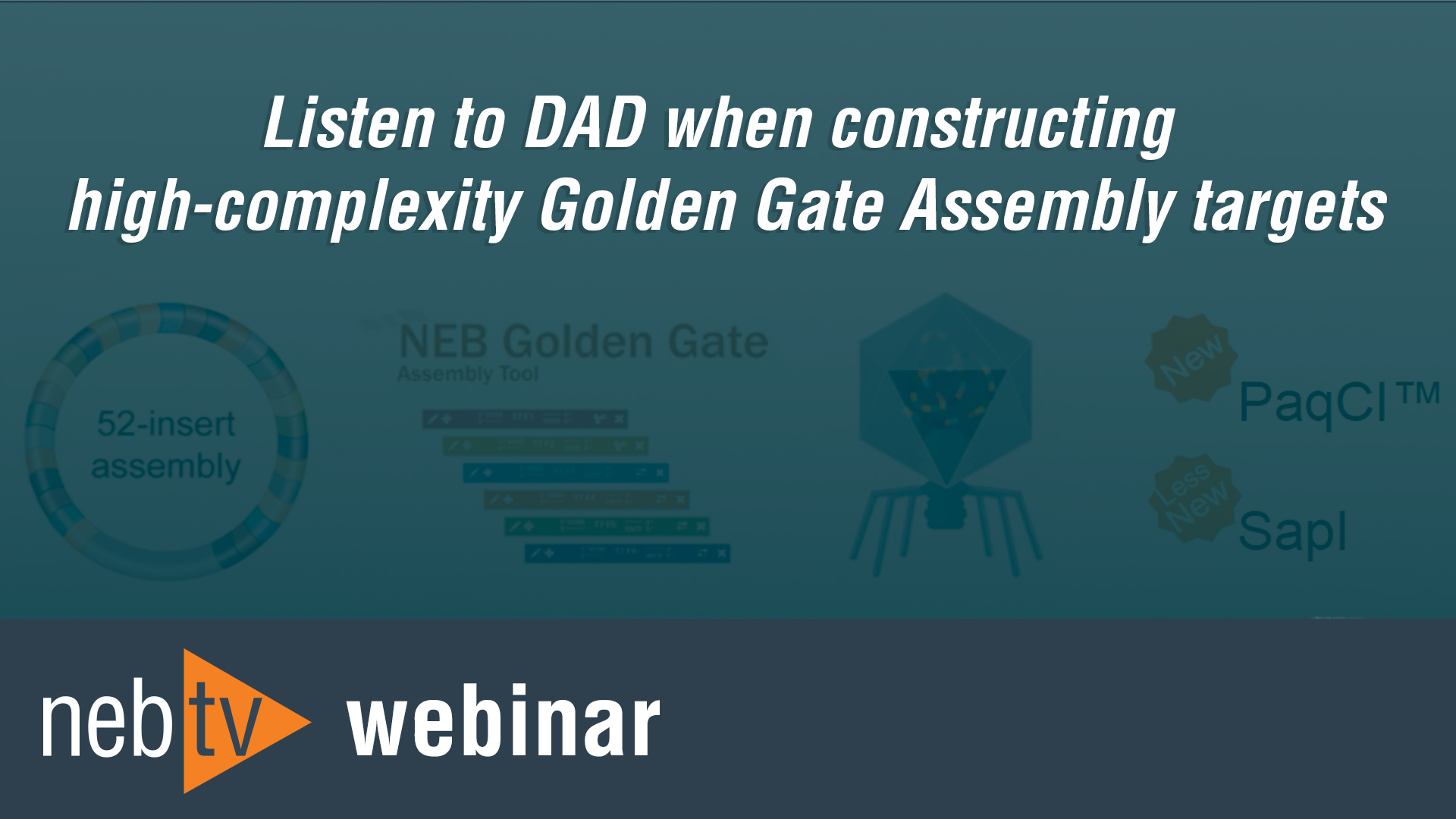24-Fragment Golden Gate Assembly using BsaI-HF®v2 (NEB #R3733)
Overview
Golden Gate Assembly of 24 fragments using BsaI-HFv2 restriction enzyme with T4 DNA Ligase and subsequent transformation into NEB 10-beta Competent E. coli (High Efficiency).
Materials
- T4 DNA Ligase (NEB #M0202)
- BsaI-HFv2 (NEB #R3733)
- pGGAselect Destination Plasmid*
- NEB 10-beta Competent E. coli (NEB #C3019)
- NEB 10-beta/Stable Outgrowth Medium (NEB #B9035)
- LB Agar plates with chloramphenicol
* Included in the NEBridge® Golden Gate Assembly Mix (NEB #E1601)
Note: For complex (>10 fragment) assemblies, high efficiencies are achievable with increased ligase and BsaI-HFv2 levels (1000 units T4 DNA Ligase, 30 units BsaI-HFv2), as listed in this protocol. For assemblies involving 10 fragments and less, the standard amounts (500 units T4 DNA Ligase, 15 units BsaI-HFv2) are sufficient. Note the reaction volume of 25 µl is used to allow sufficient volume for precloned insert additions, if needed.
Reaction Set-up
Set up 25 µl assembly reaction as follows:
| REAGENTS | ASSEMBLY REACTION | NEGATIVE CONTROL (IF DESIRED) |
|---|---|---|
| pGGAselect Destination Plasmid(1)*, 75 ng/μl | 1 μl (75 ng) | 1 μl (75 ng) |
| 24 precloned inserts(2) cloned into pMiniT 2.0, 100 ng/ul each plasmid | 0.75 µl (75 ng) each, (18 µl total) | - |
| T4 DNA Ligase Buffer (NEB #B0202) (10X) | 2.5 μl | 2.5 μl |
| T4 DNA Ligase (NEB #M0202), 2000 U/µl | 0.5 μl (1000 units) | 0.5 μl (1000 units) |
| BsaI-HFv2 (NEB #R3733), 20 U/µl | 1.5 μl (30 units) | 1.5 μl (30 units) |
| Nuclease-free H2O (NEB #B1500) | to 25 µl | 19.5 μl |
* or user provided
(2) Precloned inserts must possess 5 ́ flanking bases (6 recommended) and BsaI-HFv2 restriction sites at both ends of the
inserts and in the proper orientation.
Reaction Assembly Protocol
| SUGGESTED ASSEMBLY PROTOCOL |
|---|
| (37°C, 5 min → 16°C, 5 min) x 30 → 60°C, 5 min → 4°C(3) |
the transformations.
Transformation
- For each assembly, thaw a 50 µl tube of NEB 10-beta competent E. coli cells on ice for 5–10 min.
- Add 2 µl of the assembly reaction; gently mix by flicking the tube 4-5 times.
- Incubate on ice for 30 min.
- Heat shock at 42°C for 30 sec.
- Place back on ice for 5 min.
- Add 950 µl of room temperature NEB 10-beta/Stable Outgrowth Medium (NEB #B9035). Incubate at 37°C for 60 min., shaking vigorously (250 rpm) or using a rotation device.
Plating
- Warm LB agar plates containing chloramphenicol (for pGGAselect) at 37°C for 15 min.
- Mix the cells thoroughly by flicking the tube and inverting, then spread 100 µl outgrowth onto each plate.
- Incubate the plates overnight at 37°C, or 24 hrs at 30°C, or 48 hrs at 25°C.

References
- NEBridge® Golden Gate Assembly Tool
- Ligase Fidelity Tools
- Golden Gate Assembly Resource Page
- Webinar: Fidelity and Bias in End-Joining Ligation: Enabling complex, multi-fragment Golden Gate DNA Assembly
- Potapov, V. et al. (2018). ACS Synth. Biol. https://doi.org/10.1021/acssynbio.8b00333


